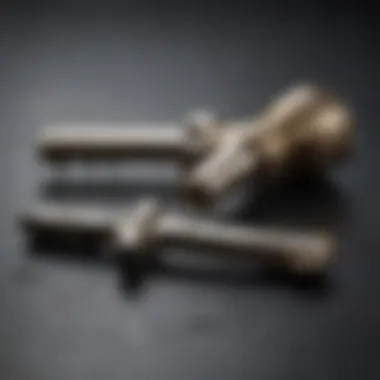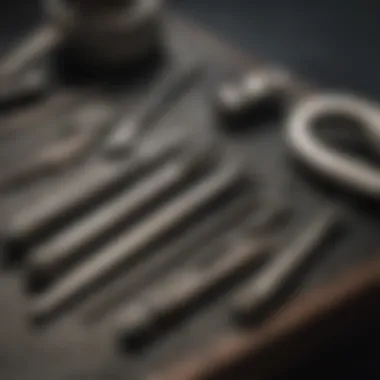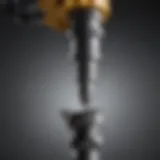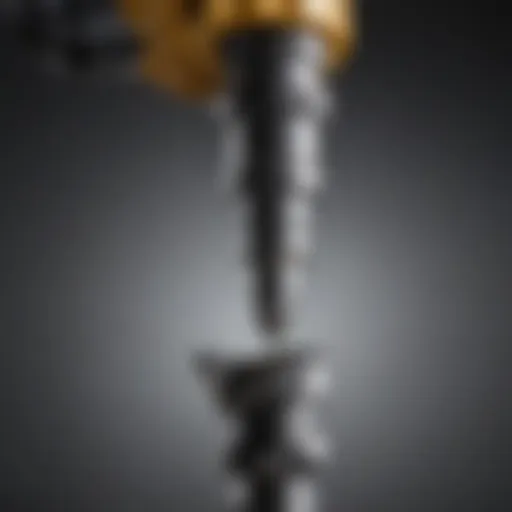Essential Tools for Using SharkBite Fittings


Intro
SharkBite fittings have gained popularity in the plumbing industry for their ease of use and efficiency. These push-to-connect fittings simplify the often tedious process of plumbing installations and repairs. Unlike traditional fittings, they do not require soldering or specific tools, making them accessible for both experienced plumbers and DIY enthusiasts. This article will thoroughly explore the essential tools needed to effectively work with SharkBite fittings. This guide aims to provide practical insights for homeowners wanting to enhance their plumbing skills as well as for those looking to maintain their systems.
Overview of Topic
Working with SharkBite fittings requires specific tools that ensure a successful installation. Tools like pipe cutters, deburring tools, and insertion depth gauges are not merely helpful but essential for optimal results. Each tool plays a critical role in preparation, installation, and maintenance phases.
The importance of using these tools cannot be understated. Proper preparation with the right tools significantly minimizes errors. Moreover, secure connection of fittings leads to durability and longevity within plumbing systems. Homeowners need to understand how to utilize these tools to not only achieve their immediate plumbing objectives but to promote a reliable system overall.
Common Challenges and Solutions
Common issues homeowners face often stem from improper preparation or inadequate tools. For instance, failure to deburr or properly cut pipes can lead to leaks. Homeowners may also struggle with measuring insertion depth, which is crucial for a secure fitting.
Solutions and Tips
- Deburring: Always deburr the pipe before installation to prevent leaks. Use a deburring tool to achieve a smooth edge.
- Insertion Depth: Measure insertion depth carefully. The SharkBite fittings come with a depth gauge for reference.
- Pipe Cutter: Invest in a quality pipe cutter to ensure clean cuts that prevent jagged edges, aiding in better sealing.
Using the right tools reduces the chance of misalignment and guarantees a secure fit.
Product Recommendations
When it comes to tools for SharkBite fittings, choosing recognized industry brands is vital. Here are some recommended products:
- SharkBite Pipe Cutter
This tool is specifically designed for cutting various types of pipes cleanly and efficiently. The rotating cutting mechanism helps achieve a precise cut without damaging the pipe integrity. - SharkBite Deburring Tool
Essential for ensuring smooth edges, this tool removes burrs effectively, allowing for secure fittings that do not leak. - SharkBite Depth Gauge
This handy tool guarantees that pipes are inserted to the correct depth for optimal connection, preventing common issues that arise from improper installation.
Step-by-Step Guides
Implementing improvements or effective solutions when working with SharkBite fittings can be straightforward. Here is a step-by-step guide:
Step 1: Gather Your Tools
Before starting, ensure you have the necessary tools ready—pipe cutter, deburring tool, and depth gauge.
Step 2: Prepare the Pipe
Cut the pipe using the pipe cutter, ensuring you make a straight cut. Deburr the edge with the deburring tool to ensure a smooth entry into the fitting.
Step 3: Measure Insertion Depth
Use the depth gauge provided by SharkBite to ensure proper insertion depth before push fitting.
Step 4: Connect the Fitting
Align the fitting with the pipe and push firmly until it reaches the defined depth. Ensure the fitting is secure and properly seated before proceeding.
Step 5: Test for Leaks
After installation, turn on the water supply. Inspect for any leaks around the fittings. If leaks are present, check if the fitting is properly seated and that the pipe was cut and deburred correctly.
By following these steps and utilizing the right tools, the installation of SharkBite fittings can be done efficiently and effectively. The audience for this guide—from active homeowners to professionals—will appreciate the clarity and simplicity provided in these instructions.
Intro to SharkBite Fittings
The use of SharkBite fittings has transformed plumbing practices by offering innovative solutions to connect piping systems with greater ease and reliability. In this article, we explore the fundamental tools necessary to employ these fittings effectively. Understanding the technology and its benefits is crucial for both novice homeowners and experienced plumbing professionals.
Understanding SharkBite Technology
SharkBite technology is characterized by its push-to-connect mechanism, which allows users to rapidly join pipes without traditional soldering or special fixtures. This is particularly advantageous during renovations or repairs where speed and accessibility are paramount. The fittings are compatible with various pipe types, such as copper, PEX, and CPVC, making them a versatile choice in plumbing applications. The unique conical design within the fitting creates a secure grip on the pipe without the need for tools, resulting in significant time savings during installations.
SharkBite fittings are engineered to withstand high pressure and temperature, meeting industry standards for quality. They incorporate a patented O-ring sealing technology that prevents leaks while maintaining ease of disassembly. This is crucial for future repairs or modifications, allowing homeowners to make adjustments without the need for extensive tools.
Benefits of Using SharkBite Fittings
One of the primary benefits of SharkBite fittings is their simplicity of use. Homeowners can complete plumbing tasks more efficiently, potentially saving on labor costs if they choose to undertake projects themselves. The fittings provide a reliable and durable solution, minimizing the likelihood of leaks and repairs down the line.
The installation is also clean and straightforward. There is no need for messy adhesives or heating elements, reducing preparation time and the risk of errors. This factor contributes significantly to the growing popularity of SharkBite fittings among DIY enthusiasts.
Another noteworthy advantage is the flexibility these fittings offer. They allow for easy conversion between different types of piping systems, accommodating renovations or expansions that may involve multiple materials.
In summary, the utilization of SharkBite fittings streamlines plumbing tasks, leading to efficient use of time and resources. By embracing the technology and understanding its benefits, homeowners and professionals alike can enhance their plumbing toolkit, making installations and repairs more effective.
Essential Tools Overview


In any plumbing project, especially when working with SharkBite fittings, having the right tools is crucial. Using the proper tools not only simplifies the installation process but also helps to ensure that the connections are secure and long-lasting. Without the right tools, one risks making mistakes that can lead to leaks or even more serious plumbing issues.
The effectiveness of SharkBite fittings relies greatly on the precision with which they are installed. This means that each tool used should be tailored to enhance this precision. For example, the right pipe cutter can make a clean, straight cut, which is essential for creating an effective seal when joining pipes. Similarly, having a deburring tool at hand helps eliminate sharp edges that may compromise the quality of the connection.
Furthermore, using high-quality tools not only improves the outcome of the installation but also saves time and effort. Good tools reduce the margin for error, allowing you to install the fittings with confidence.
Importance of Proper Tools
Having the right tools for the installation of SharkBite fittings makes a significant difference in the overall quality of the work. Proper tools help ensure accurate cuts and fittings, reducing the chance of leaks. Additionally, specific tools designed for tubing can enhance the connection integrity, making it safer and more efficient to install plumbing systems.
Consider the impact of using substandard or incorrect tools. A dull pipe cutter can create jagged edges, limiting the effectiveness of the fittings. This not only can lead to regrettable leaks post-installation but also results in wasted materials and additional costs to rectify the mistakes. Therefore, investing in proper tools is not merely a choice; it is an essential step in ensuring a successful plumbing project.
Tool Quality Considerations
When selecting tools for working with SharkBite fittings, quality should be top of mind. High-quality tools are designed to withstand the rigors of plumbing tasks while providing consistent performance. Look for tools made from durable materials, as they will not only last longer but will also perform better.
For instance, stainless steel pipe cutters generally provide smoother cuts than their plastic counterparts, ensuring that the surface of the pipe is ready for the fitting connection. Additionally, precise calibration is key in tools like depth gauges, where even a minor miscalculation can affect the performance of the fittings.
It's important to check for reputable brands known for their quality within the plumbing industry. These brands often provide warranties or guarantees that further ensure that you are making a worthwhile investment.
The Must-Have Tools
Using SharkBite fittings effectively demands specific tools. Each of these tools plays a unique role in ensuring successful installations. Without adequate instruments, the application of SharkBite fittings can become troublesome and unsecure. The right tools enhance efficiency, safety, and overall quality of plumbing work. Let's explore the essential tools that every installer should have.
Pipe Cutter
Features to Look For
When selecting a pipe cutter, consider its cutting capacity and ease of use. A good pipe cutter should have a sharp blade and an adjustable handle for different pipe sizes. These features significantly influence cutting precision. The ability to cut without damaging the pipe is equally important. A tool designed for durability can save time and decrease the frequency of replacements. A well-chosen pipe cutter leads to cleaner cuts, making the installation process smoother.
Safe Usage Tips
Safety is paramount when using a pipe cutter. Always wear safety glasses to prevent debris from causing eye injuries. Ensure the pipe is stable before cutting, and apply even pressure. This prevents slips and ensures a clean cut. Familiarize yourself with the cutter's mechanism to enhance handling. Proper use reduces the risk of injury and enhances the effectiveness of the tool.
Deburring Tool
Why Deburring is Necessary
Deburring tools are essential to achieve smooth edges after cutting pipes. Irregular edges can interfere with connections, leading to leaks. A deburring tool ensures that the pipe ends are perfectly smooth, allowing fittings to seat correctly. This tool is vital for maintaining the integrity of your plumbing connections.
How to Use a Deburring Tool
Using a deburring tool is straightforward. Place the pipe end against the tool and rotate until smooth. This technique can remove sharp edges effectively without damaging the pipe. Regular use of a deburring tool improves installation quality and extends the lifespan of fittings by ensuring they fit securely.
Depth Gauge
Purpose of a Depth Gauge
A depth gauge is critical for determining the insertion depth of the fittings. This measurement ensures that the fittings are correctly seated within the pipes, preventing leaks. Accurately placing the fittings reduces the risk of potential plumbing issues later. A depth gauge provides peace of mind that each connection is made correctly.
Calibration Techniques
To ensure accurate readings, regularly calibrate your depth gauge. This involves checking against a known standard for accuracy. Calibration is essential, especially if the tool is frequently used. A well-calibrated depth gauge is more reliable and enhances accuracy in your installations.
Wrenches and Pliers
Different Types of Wrenches
Various wrenches serve different purposes. Adjustable wrenches are versatile for various fittings. Specialized tight spaces may require ratcheting wrenches, which allow easier access without repositioning the tool. The right type of wrench improves the ease of connection, thus reducing installation time.
Proper Techniques for Tightening
Using the correct technique when tightening fittings is vital. Avoid over-tightening, as this can damage both the fitting and the pipe. Instead, apply firm, steady pressure, ensuring a secure connection without risking leaks. Knowledge of tightening techniques is essential for anyone using SharkBite fittings.
Pipe Inspection Mirror
Enhancing Visibility in Tight Spaces
A pipe inspection mirror allows access to difficult angles. Visibility is crucial for checking connections in tight spaces. Using a mirror can catch issues early, preventing significant complications later in the plumbing work. This tool is especially helpful for thorough inspections during and after installation.
Selecting the Right Mirror
Choose a mirror that offers a clear view while being compact enough for small areas. Mirrors with adjustable handles can extend reach, which is essential for those hard-to-reach spots. The right inspection mirror will pay off by making presentations more efficient.
Teflon Tape


Application Techniques
Using Teflon tape properly is key to preventing leaks. Wrap the tape around threaded areas clockwise, ensuring even coverage without overlaps. This application technique minimizes the risk of tape tears during installation. Applying Teflon tape correctly can drastically improve the performance of fittings, ensuring tight seals.
Benefits of Using Teflon Tape
Teflon tape provides a barrier against leaks and enhances joint integrity. This simple material is effective at preventing water from escaping at connection points. It is also versatile and easy to apply, making it a staple in plumbing toolkits.
Plumber's Putty
Effective Use Cases
Plumber's putty is useful in various applications such as sealing drains and fixtures. It can prevent leaks around sink and tub drains. The use of putty allows for a flexible seal that can be adjusted without needing replacements. Understanding its proper use is vital for achieving solid plumbing connections.
Safety Considerations
When using plumber's putty, be aware of its chemical composition. Work in well-ventilated areas to avoid inhaling fumes. Always follow manufacturer instructions for best use practices. Safe handling can prevent unnecessary exposure to harmful substances while working on plumbing tasks.
Safety Gear
Importance of Personal Protective Equipment
Personal protective equipment is crucial for keeping safe during plumbing tasks. Safety glasses and gloves can protect against sharp objects and chemical exposure. Wearing the appropriate gear minimizes the risk of injury, making safety gear a necessary component of any plumbing tool kit.
Recommended Safety Gear
Consider investing in high-quality safety glasses and durable gloves. A hard hat may also be useful in certain situations where overhead dangers may exist. Ensuring you have the right safety equipment can make your plumbing tasks safer and more productive.
Preparation for Installation
Preparation for installation is a crucial phase that lays the foundation for successful plumbing projects using SharkBite fittings. It involves not only the physical assessment of the workspace but also the meticulous gathering of tools and materials needed for the task. Taking these preliminary steps seriously can significantly enhance efficiency, ensure safety, and contribute to the overall success of the plumbing installation.
Proper preparation enables the installer to foresee potential challenges. This includes understanding the layout of existing pipes, the dimensions of the spaces involved, and any obstacles that may hinder access. Preparing the installation site can also help ensure that all necessary tools are easily at hand, minimizing disruptions during the actual installation process.
Additionally, a well-prepared site reduces the risks of errors. Awareness of the environment leads to better decision-making, whether it concerns the angle of cuts or the connections to be made. Each of these factors plays a role in achieving a secure and leak-free installation with SharkBite fittings.
Assessing the Site
When it comes to assessing the site, thoroughness is essential. Start by inspecting the area where the installation will occur. Look for any existing plumbing, electrical lines, or obstacles that may obstruct your work. Understanding these factors beforehand can save significant time and effort.
During your assessment, it's important to take measurements. Determine the length and size of pipes involved and identify the location of SharkBite fittings. Make sure to check for adequate space around the fittings for proper installation. Additionally, check whether the surfaces are clean and free of debris.
Another vital aspect to consider is the condition of existing pipes. Look for any signs of wear, corrosion, or damage. This might indicate whether you need to replace any components or simply proceed with the installation. Keep in mind that the efficiency of your plumbing system heavily relies on having a clear assessment of your materials and surroundings.
Gathering Tools and Materials
Once the site assessment is complete, the next step is gathering the necessary tools and materials. This stage is equally important to ensure a fluid installation process. Begin by compiling a checklist of all required tools based on the project’s specific needs.
Some of the essential items include:
- Pipe Cutter: For clean and precise cuts.
- Deburring Tool: To ensure that edges are smooth.
- Depth Gauge: To measure proper insertion depth of fittings.
- Wrenches and Pliers: For tight connections.
- Pipe Inspection Mirror: To see hard-to-reach areas.
- Teflon Tape and Plumber's Putty: For sealing connections.
- Safety Gear: To protect yourself during installation.
Before starting your project, lay all gathered tools and materials close to the installation area. This not only saves time but also minimizes inconvenience during the work. Finally, conducting a last-minute check to ensure everything is in place allows you to focus solely on the installation, reducing the chances of interruptions.
"Preparation is the key to success; a well-prepared site will always yield better results in plumbing projects."
Proceeding without proper preparation can lead to unnecessary complications. With a clear understanding of the site and the right tools in place, you set the stage for a smooth and effective installation of SharkBite fittings.
Installation Techniques
Understanding proper installation techniques is central to achieving effective results when using SharkBite fittings. These fittings are designed for ease of use, yet the benefits of efficient installation go beyond simplicity. A correct installation ensures that plumbing systems function optimally and helps to prevent any potential leaks or future complications.
Step-by-Step Installation Process
When installing SharkBite fittings, following a systematic approach is imperative. This process includes several key steps:
- Planning the Installation:
- Cutting the Pipe:
- Deburring the Pipe:
- Marking the Insertion Depth:
- Installing the SharkBite Fitting:
- Testing the System:
- Before you begin, assess the area where the installation will take place. Ensure that you have enough access, as tight spaces can complicate the work.
- Gather all necessary tools and materials to avoid interruptions during the process.
- Use a pipe cutter for clean cuts. Ensure that the ends of the pipe are straight and free from burrs.
- Measure the length accurately to prevent wastage.
- After cutting, utilize a deburring tool to remove any sharp edges. This step is crucial for allowing a snug fit of the fitting and preventing damage.


- Use a depth gauge to measure the insertion depth. Accurately mark this on the pipe to avoid any installation errors.
- Align the fitting with the marked depth and press it onto the pipe firmly until it reaches the mark.
- Verify that the fitting is fully inserted into the pipe for optimal sealing.
- Once the installation is complete, turn on the water supply and check for leaks. Inspect the fittings and make adjustments as necessary.
Following these steps methodically will lead to a secure connection, enhancing the longevity of the installed system.
Common Pitfalls to Avoid
Even with a straightforward process, mistakes can happen. It’s important to be aware of common pitfalls:
- Improper Cuts: A slanted or uneven cut can impede the fitting's ability to seal properly.
- Neglecting Deburring: Failing to deburr the pipes can lead to damage to the inner seal of the fitting.
- Ignoring the Depth Mark: Not adhering to the insertion depth marked can result in inadequate sealing.
- Overtightening: Applying excessive force while tightening can lead to damage to the fittings or pipes.
Proper installation practices significantly reduce the risk of future plumbing issues.
By recognizing these pitfalls and adopting effective installation techniques, homeowners can confidently make plumbing repairs or installations, ensuring their systems remain reliable for years to come.
Post-Installation Checks
After the installation of SharkBite fittings, conducting thorough post-installation checks is crucial. This phase serves to ensure that the plumbing system operates as intended. Neglecting this important step can lead to a variety of issues, including water damage and costly repairs. Having confidence in your installation will provide peace of mind and ensure long-lasting functionality.
Testing for Leaks
Testing for leaks is one of the first tasks in the post-installation process. Leaks can occur due to improper connections, pressure fluctuations, or even installation errors. To conduct a leak test, follow these steps:
- Visual Inspection: Check all connections and fittings for any visible sign of moisture or dripping water.
- Pressurization Method: Increase the water pressure in the system. Observe the joints and surrounding areas closely. A sudden drop in pressure may indicate a leak.
- Soapy Water Application: Coat the fittings and joints with a solution of soapy water. Any bubbles that form will signal a leak.
Conducting these tests not only identifies potential leaks but also adds to the overall safety of your plumbing system. Addressing leaks immediately can help prevent major problems down the line.
Ensuring a Secure Connection
Once leak testing is complete, it is essential to ensure that all connections remain secure. A loose fitting can lead to leaks over time and create a hazardous situation. Here are a few points to consider:
- Visual Confirmation: Examine each connection visually to check if they appear snug and properly aligned.
- Tightening Techniques: If any fittings appear loose, use the proper tools, such as wrenches or pliers, to gently tighten without overtightening, which can cause damage.
- Review Manufacturer Specifications: Always refer to the manufacturer's recommendations for connection securement. This should ensure all fittings are installed correctly and safely.
Maintenance and Troubleshooting
Maintaining and troubleshooting SharkBite fittings are crucial practices that ensure their longevity and reliable performance. Proper maintenance can prevent significant issues before they arise, allowing homeowners to avoid costly repairs in the long run. It also ensures that the plumbing system functions optimally under various conditions. A knowledgeable approach to maintenance and troubleshooting can empower housewives and homeowners to tackle minor problems confidently.
By adopting routine practices, one lays the groundwork for the durability of the fittings. This attention to detail is beneficial not just for immediate peace of mind but for extending the life of the plumbing systems as a whole. A well-maintained system can enhance efficiency and minimize water waste, contributing to both environmental sustainability and cost savings.
Routine Maintenance Practices
To keep SharkBite fittings in good working condition, certain routine maintenance practices should be implemented.
- Regular Inspections: Check for visible signs of wear or damage. Observing any leaks, corrosion, or degradation in connections is vital.
- Cleaning: Ensure that the fittings and surrounding areas are clean. This can prevent buildup that might affect their function over time.
- Seal Checks: Periodically examine the integrity of seals and O-rings. If they appear frayed or worn, they should be replaced promptly to prevent leaks.
- System Flushing: Perform system flushes to remove any debris buildup that could interfere with the fittings. This practice is especially beneficial in areas with hard water, where mineral deposits can accumulate.
- Assembly Rechecks: A follow-up examination of connections after installation can be beneficial in identifying any loosening that might occur from temperature fluctuations or pressure changes.
These maintenance activities should be scheduled routinely, such as bi-annually or annually, depending on the frequency of use and the environment.
Identifying Common Issues
Even with proper maintenance, issues may arise with SharkBite fittings. Identifying these common problems early can save money and prevent larger issues.
- Leakage: This could be caused by improper installation or malfunctioning seals. If a leak is detected, immediate action is necessary—tightening connections or replacing seals can often rectify the problem.
- Discoloration of Fittings: Changes in color, such as rust or dark spots, can indicate corrosion. This could be a sign of improper water chemistry or external factors and should be looked into without delay.
- Difficulty in Connection: If fittings are becoming hard to engage, it could indicate debris in the pipe or that the fitting itself is damaged. Inspect and clean the connection area to restore functionality.
- Reduced Water Flow: If you notice decreased water pressure, check for clogs within the fittings or upstream in the system. Ensure that nothing is obstructing the pipes.
By being vigilant and addressing these common issues as they arise, homeowners can maintain the capability and efficacy of their plumbing systems.
Regular maintenance and timely troubleshooting are the keys to securing the lifetime performance of your SharkBite fittings.
Summary and Culmination
In this article, we have explored the essential tools needed for effective use of SharkBite fittings. These tools are not just accessories, but crucial components that guarantee a secure and efficient plumbing installation. Understanding the significance of each tool aids both novice DIYers and seasoned professionals in optimizing their plumbing tasks.
Recap of Essential Tools
To summarize, the fundamental tools identified in this guide include:
- Pipe Cutter: Facilitates clean cuts on pipes, ensuring proper fitment.
- Deburring Tool: Removes rough edges from cut pipes, allowing for smooth connections.
- Depth Gauge: Ensures precise insertion depth for fittings.
- Wrenches and Pliers: Helps secure fittings properly to prevent leaks.
- Pipe Inspection Mirror: Enhances visibility in tight or hard-to-reach spaces.
- Teflon Tape: Assists in sealing threaded joints.
- Plumber's Putty: Used for sealing and protecting various connections.
- Safety Gear: Protects the individual performing the installation from potential hazards.
Each of these tools plays an essential role in creating a reliable plumbing system that serves its purpose effectively and lasts longer. Their combined utility cannot be understated, as they collectively contribute to the quality of installations.
Final Thoughts on SharkBite Usage
By employing the correct practices and maintaining an understanding of individual tool functions, homeowners and DIY enthusiasts can effectively tackle plumbing projects. This not only offers substantial cost savings but also allows for a greater sense of accomplishment.
Investing in quality tools will pay off in the long run, as they ensure the longevity and reliability of plumbing systems. Understanding the utility and application of each tool encourages good habits and enhances confidence in performing installations, repairs and maintenance.
"Success in plumbing is rarely an accident; it is always a result of high intention, sincere effort, and thorough preparation."
Through careful application of these guidelines, one can navigate the world of SharkBite fittings with ease, achieving results that meet or exceed professional standards.







